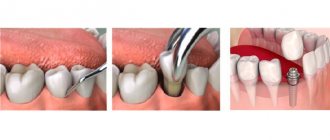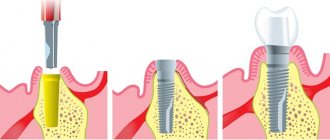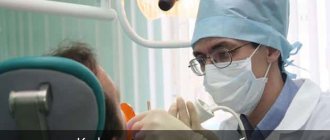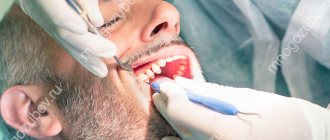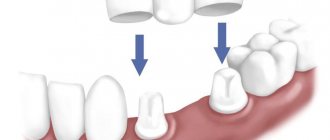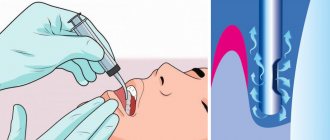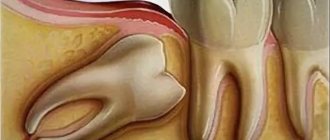Losing teeth is always a problem. No front ones - goodbye beautiful smile. It was not possible to maintain a “five” or “six” - there will be difficulties with chewing. Even if only one tooth is missing, the picture will be unpleasant: the neighboring ones will begin to loosen and “diverge”, trying to take the place of their retired brother.
There is only one way out in this situation: to restore a healthy and aesthetic smile, you need to insert teeth. Prosthetics, in addition, is the most effective “cure” for the psychological discomfort that people experience due to obvious defects in the dentition.
Features of dental implantation
The implantation procedure involves inserting an artificial root - an implant - into the bone tissue of the jaw. The procedure takes place in several stages with a certain time interval, which depends on the degree of survival of the metal structure in the bone tissue.
Time to install dental implants
is ambiguous and depends on the chosen method of carrying out the procedure.
There are several implantation methods:
implantation using the transgingival method;
express implantation (one-step procedure);
- basal and other modern techniques.
Each procedure has its own indications and contraindications, so the choice of method is determined by the attending dentist-implantologist.
Does it hurt to put teeth in?
It is impossible to say that it is possible to insert ceramic teeth so that the patient does not experience discomfort at any stage. Any prosthesis cannot be made perfectly right away, so it must be adjusted. And if a chewing tooth is inserted incorrectly, it can touch soft tissue when a person chews or even talks. Sometimes even a patient can come and start complaining that after he had a tooth inserted, it hurts. On the one hand, this may seem funny, since an artificial structure cannot hurt on its own. On the other hand, this is a reason to pay attention to the condition of soft tissues, because they are the ones that can hurt and become inflamed. If the prosthesis is made on an inlay, that is, with a real tooth root, then there may be options for the development of periostitis and other inflammatory processes. It is enough for the infection to get into the canal at the root, and the body may not be able to cope with it on its own.
Not only a ceramic tooth can be inserted unsuccessfully, but also a plastic or metal-ceramic one. If possible, the doctor should adjust such a prosthesis on the day of installation so that the patient does not experience pain. The most difficult thing is with removable dentures, as they require long-term correction. Initially, the installation of this orthopedic structure does not cause discomfort, but it may appear later, when the patient has already left the office.
Such dentures rub the gums, so they have to be ground down, and it is not always possible to identify all the problem areas the first time, so that a person feels with the removable structure as with his own teeth. But this is a good way to insert teeth on a limited budget.
Prosthetics for periodontitis and periodontal disease
Installation of permanent dentures (dental bridges) in case of generalized periodontitis and periodontal disease is impossible, since the structures are based on two supporting, living and healthy teeth. If you fix them on loose ones, the prosthesis will have mobility, and the teeth will simply break. That is why the only option for classical prosthetics for patients with periodontal disease is removable dentures. In addition, removable clasp dentures with metal hooks allow you to fix slightly mobile teeth.
Prices
On average, prices for prostheses and services for their installation in private clinics in Moscow are as follows:
- onlays – 12,200 rubles for one veneer;
- inlays – 5,300 rubles for one microprosthesis;
- crowns – 3,750 rubles for a metal structure, 8,590 rubles for metal-ceramics and from 13,000 rubles for ceramics;
- bridges – 25,200 rubles;
- complete dentures – 26,700 rubles;
- partial dentures - from 4,000 rubles for a denture for one or two teeth and from 20,000 rubles for a denture with a large number of artificial teeth;
- implants – 51,300 rubles per one.
Dental implantation
Are implants used for periodontal disease?
Modern prosthetic techniques make it possible to create an ideal smile and restore dentition even in the most severe cases. And when asked by patients whether implants are placed for periodontal disease, professional dentists answer in the affirmative
Types of implantation
In dentistry, you can place implants, including for periodontal disease - dentists simply use a more conservative classical method in such a situation. 1–2 months after tooth extraction, an artificial tooth root is implanted into the bone tissue area. After some time, after the implant is securely fixed in the bone, it is used to fix a single crown or as a reference point for a bridge.
It is also possible to use a modern express method of simultaneous implantation. It looks like this: immediately after sanitation of the oral cavity and removal of affected teeth due to periodontal disease, implants are placed, which are fixed in the deepest layers of bone tissue. In fact, these are ideal artificial roots: they are superior to natural ones because they help strengthen bones thanks to their special shape. First, they are hidden under temporary crowns, and after the implants have taken root, a permanent prosthesis will be installed on them. This method has several advantages: it is effective and, although it cannot be called absolutely painless, it still does not cause severe suffering to the patient. In addition, everything can be done in one visit, even if several (or even all!) teeth are lost: “new” roots are not implanted into every hole - it is enough to install 4, 6 or 12 units.
Stages of prosthetics
Successful installation of implants largely depends on strict and consistent adherence to all stages of the operation and careful preparation for it.
First actions
If the tooth left its natural “habitat” unharmed, and you managed to find it, then you can count on the restoration of the unit. Find a small container, pour saline solution and place the tooth there. If you don’t have the necessary items on hand, you can wrap the unit in regular cloth or cotton wool. If possible, place a special cold pack next to the unit; it can be purchased at a pharmacy. In extreme cases, use ice.
If there is no heavy bleeding, it is enough to treat the oral cavity with any antiseptic liquid, Miramistin or Chlorhexidine will do. If there is severe pain, take any painkiller tablet, for example, Nise or Ketarol.
In case of heavy bleeding, you should immediately visit a doctor or call an ambulance.
How is preparation for implantation carried out for periodontal disease?
- Before implantation, a thorough sanitation of the oral cavity is carried out - professional hygienic cleaning, removal of necrotic tissue, cleaning of gum pockets, treatment with medications.
- Teeth are removed and single-piece implants with aggressive threads are implanted in their place.
- After 2-3 days, prosthetics are performed with a permanent lightweight metal-plastic prosthesis, equipped with a small gum substitute in case of significant atrophy.
Regular loading has a beneficial effect on the bone, and the process of its fusion with the implant occurs very quickly.
Where to get teeth inserted inexpensively?
The most budget-friendly option for prosthetics is crowns and bridges made of metal-ceramics; implantation with Alpha Bio and Astra Tech implants is relatively inexpensive.
In state dental clinics, prosthetics will cost an average of 7,000 rubles for metal-ceramic crowns, 21,000 rubles for a metal-ceramic bridge of three units. The work of implanting an implant is estimated at approximately 16,000 rubles (excluding the cost of the implant).
Under state insurance, teeth cannot be inserted for free, since prosthetic services are not included in compulsory medical insurance.
Features and dangers of periodontal disease
Special offers
What's included?
- Heal former
- Abutment installation
- Implant Nobel Parallel CC (Switzerland)
- Full zirconium crown in full anatomy with screw fixation Multilayer, Luxen Smile Multi
- Casts
- Control examinations
- Lifetime Warranty!
What's included?
- Heal former
- Abutment installation
- Implant Astra Tech (Switzerland)
- All-zirconium crown Multilayer, Luxen Smile Multi with screw fixation
- Casts
- Control examinations
- Lifetime Warranty!
What's included?
- Work of all doctors, including consultation, examination and treatment plan
- Adin implant (Israel) with conical fixation
- Abutment, former
- All-zirconium screw-retained crown , impressions
- Control examinations
- 10 year guarantee!
What's included?
- Doctor's work
- Examination, consultation, treatment plan
- Fixation
- Cost of tab with installation
- Warranty corrections
What's included?
- Work of all doctors, including consultation, examination and treatment plan
- Ankylos implant (Germany)
- Abutment, former
- All-zirconium screw-retained crown , impressions
- Control examinations
- Lifetime Warranty!
What's included?
- Heal former
- Abutment installation
- Implant Alpha-Bio ICE (Israel)
- screw-retained Multilayer crown
- Control examinations
- 5 year warranty
What's included?
- Doctor's work
- Examination, consultation, treatment plan
- Fixation
- Cost of CAD/CAM crown with installation
- Warranty corrections
What's included?
- Doctor's work
- Examination, consultation, treatment plan
- Fixation
- Cost of CAD/CAM crown with installation
- Warranty corrections
What's included?
- Doctor's work
- Examination, consultation, treatment plan
- Fixation
- Cost of CAD/CAM crown with installation
- Warranty corrections
What's included?
- Doctor's work
- Examination, consultation, treatment plan
- Fixation, tooth preparation
- Cost of veneer with installation
- Warranty corrections
What's included?
- Doctor's work
- Examination, consultation, treatment plan
- Fixation
- Cost of CAD/CAM crown with installation
- Warranty corrections
What's included?
- Turnkey metal ligatures — 98,000₽
- Self-ligating metal turnkey — 160,000₽
- Self-ligating ceramic turnkey — 170,000₽
- Turnkey ceramic ligatures - 155,000₽
- Turnkey sapphire ligatures — 165,000₽
- Turnkey lingual braces — 188,000₽
What's included?
- The procedure lasts 60 minutes
- Teeth whitening by 6-12 shades
- Duration of effect - 2 years
- Teeth sensitivity does NOT increase!
- Selecting the desired color before the procedure begins
What's included?
- Protective measures
- Ultrasonic cleaning
- Fluoridation of enamel
- Air-Flow procedure
- Polishing with paste
What's included?
- Doctor's work
- Examination, consultation, treatment plan
- Cost of prosthesis with installation
- Warranty corrections
What's included?
- Work of doctors, including consultation;
- Complete examination and development of a treatment plan;
- Anesthesia;
- Installation of 4 Nobel Parallel CC implants (Switzerland) with conical fixation;
- Multi-unit Nobel;
- Taking impressions;
- Manufacturing of temporary reinforced composite prosthesis with screw fixation;
- Taking impressions;
- Manufacturing and installation of a permanent prosthesis with cast reinforcement;
- Control and preventive examinations
Indications and contraindications for molar tooth extraction
Reasons for removing a molar tooth may be:
- purulent periostitis;
- abscess;
- phlegmon;
- large tumor in the tooth area;
- purulent periodontal disease;
- the presence of a cyst in the area of the diseased tooth;
- exposed pulp;
- longitudinal tooth fracture;
- critical tooth decay;
- critical tooth curvature;
- disease of the dental bone tissue;
- sinusitis.
The following reasons are contraindications to the removal of molars:
- acute heart diseases;
- acute viral diseases;
- flu;
- angina;
- renal failure;
- pancreatitis;
- hepatitis;
- acute diseases of the nervous system;
- oncological diseases
- initial and final stages of pregnancy;
- stomatitis;
- gingivitis
- general degeneration of the body;
- alcohol poisoning.
Implantation techniques for periodontitis and periodontal disease
- Single implantation. It is used quite rarely, since periodontal diseases usually cover a large area of the mucous membrane.
- Bridge prosthesis supported by implants. The optimal solution for restoring a fragment of the dentition.
Periodontitis and periodontal disease often deform the gums and cause bone tissue atrophy, so in addition to the implantation itself, the patient may require osteoplastic surgery and/or soft tissue plastic surgery. Particular attention should be paid to the choice of implants. With periodontal disease, the patient’s body, as a rule, reacts sharply to foreign bodies, so even titanium can cause an allergic reaction. That is why it is recommended to use implants made from the safest alloys and with high primary stability.
The best option is zirconium dioxide implants, which are completely hypoallergenic. If it is not possible to carry out a bone tissue augmentation procedure, classical dental implantation is sometimes replaced by basal implantation. Basal implants are placed in a deeper layer of bone, which is not subject to atrophy, but the procedure itself is less predictable compared to the classical technique.
Choosing where to get treatment
You can choose a dental clinic based on price level, but you just need to make sure that they can help you there. Sometimes it happens that someone’s teeth were inserted poorly, after which complications arose or the result turned out to be unaesthetic. Typically, such patients leave unflattering reviews about a medical institution or a specific doctor. They also write where they went next, and where they managed to fix everything. However, you should not completely rely on these reviews. After all, if a person writes and does not know what kind of doctor he is who inserts teeth, what his specialty is called, then is it worth trusting such assessments? Anyone who actually underwent treatment knows for sure that he consulted an orthopedist or orthodontist, that the prosthesis was made by a dental technician - and this is a different specialist, and that the preparatory work was done by a dental therapist. In small clinics, a doctor can combine the work of an orthopedist and a therapist, but never also act as a dental technician!
So it’s always better to rely on the choice of your friends rather than on the opinion of a stranger who left a review on the site. Such a person could be hired by competitors to ruin the reputation of the dental clinic.
Implantation and dental prosthetics for periodontitis
In cases of severe atrophy of bone tissue resulting from periodontitis, two treatment options are possible:
1. Bone augmentation and subsequent implantation.
This method takes time, since it usually takes about 4 months to build up bone tissue, and 3 to 6 months for subsequent engraftment.
Thus, it takes about 7 to 10 months to carry out such treatment, from start to finish, and to fix the crowns on implants. Often, bone grafting and implantation surgery can be combined into one, doing everything in one go and saving 4 months.
2. The use of implants of a special structure , which can be installed even in conditions of severe bone atrophy, without resorting to augmentation of the jaw bone. Using this technique, you can replace both the loss of several teeth and complete loss of teeth.
Both of these techniques allow you to quickly and effectively restore teeth lost due to periodontitis and periodontal disease.
Complex dental implantation for periodontitis
The method of complex dental implantation is an excellent solution in cases of advanced periodontitis and extensive tooth loss. In this case, you get everything at once.
Let's look at the procedure for complex dental implantation in more detail:
1. Removal of teeth that have served their purpose and are mobile due to periodontitis and periodontal disease. After removal, the surgeon carefully cleans the sockets and removes any remaining inflamed tissue. 2. Installation of implants in the most favorable areas of the jaw bone tissue that have good density. Implants can be installed in the sockets of extracted teeth. 3. Immediately after the operation, all necessary impressions are taken, according to which fixed dentures are made in the dental laboratory. 7 days after the operation, the non-removable structure is fixed to the implants.
When to insert an implant immediately after extraction
If there is insufficient bone volume, installation of an artificial root in place of a lost tooth is possible only after bone grafting
- If there is inflammation;
- fistula, granuloma, cyst;
- against the background of diseases of the mucous membrane;
- with insufficient bone volume or pathological changes;
- if the removal was performed carelessly (severely injured hole) and more.
Contraindications also include systemic diseases :
- diabetes;
- pathologies of the endocrine system;
- oncology;
- mental disorders, depression;
- allergy to anesthetics;
- weakened immunity due to viral and bacterial infections;
- tuberculosis;
- HIV, syphilis;
- hemophilia and other blood diseases;
- chronic diseases at the acute stage, etc.
Sometimes situations arise when one-stage implantation is not completed. In this case, the operation is completed after extraction. The implant installation procedure is postponed for some time to allow the wound to heal. Next, treatment is performed according to the classical protocol.
Stages of dental implantation in 1 day
- Consultation and diagnosis.
The doctor assesses the condition of the oral cavity, collects anamnesis and studies X-ray data. Eliminates the presence of contraindications.
The most important stage on which the success of implantation and further prosthetics depends more than half.
A special program creates a three-dimensional, anatomically accurate model of the jaw. Taking into account the clinical picture, the doctor decides on the required number of implants (4 or 6) or the need to use 4 classic and 2 zygomatic titanium rods. Places for installing implants are selected. A surgical template is made.
Sanitation of the oral cavity.
The doctor performs a comprehensive cleaning of the oral cavity. Under local anesthesia (possibly combined with sedation), existing teeth are removed. Cleans the holes from existing inflammatory foci.
The implantologist fixes the implants at an angle. Takes impressions to make an adaptive temporary prosthesis.
Loading an implant with a fixed prosthesis.
5-7 hours after installation of the implants or on the 3rd day, they are loaded with a temporary prosthesis. The temporary prosthesis is worn for 3-6 months. During this time, the implants fuse with the bone tissue (this process is called osseointegration). Then the doctor changes the temporary orthopedic structure to a permanent one made of metal ceramics or zirconium dioxide.
I am personally responsible for the results of treatment of our patients.
Fedorov Roman Nikolaevich, chief physician and founder of the Implantation Center
Work experience over 23 years. Performed more than 400 implantations using ALL-ON-4, ALL-ON-6 technology on Nobel Biocare (incl. Zygoma), Noris Medical (incl. Zygomatic) implants.
Prices for treatment using the “Teeth in one day” technology
Cost of implantation for 1 day in Moscow in our clinic:
Consultation and treatment plan
Dental implantation using all-on-4 technology (manufacturer Israel)
150,000 rub. Promotion until March 1st! 180,000 rub.
Dental implantation using all-on-6 technology on Noris Medical implants
190,000 rub. Promotion until March 1st! 220,000 rub.
Dental implantation using all-on-4 technology on Nobel Biocare implants
320,000 rub. Promotion until the end of the month! 350,000 rub.
Dental implantation using all-on-6 technology on Nobel Biocare implants
430,000 rub. Promotion until the end of the month! 460,000 rub.
Pros and cons of technology
Teeth in 1 day is the optimal price and quality method for restoring dentition in cases of complete or partial edentia.
The “Teeth in 1 Day” technology allows you to return all teeth at 2 times cheaper than with classical implantation - a complete fixed denture is installed on 4 or 6 implants, rather than on 8 or 10.
If you choose a zirconium dioxide prosthesis, the new teeth are practically no different from your original teeth.
You will be able to chew in 1 day.
After installation of a fixed denture, you can immediately chew food. You will fully feel the taste of food.
No bone grafting.
In most clinical cases, osteoplasty can be avoided, which reduces both the time and cost of treatment.
The main disadvantage of one-day implantation is that it is not suitable for everyone. It is impossible to get new teeth in 1 day using a one-step protocol if:
- pronounced bone resorption;
- stage III periodontitis (advanced form);
- problems with blood clotting;
- pregnancy and lactation;
- allergies to local anesthetics.
What implants are used in the clinic for dental prosthetics in 1 day?
All-on-4 technology is developed by Nobel Biocare, so we expect all our patients to have all their teeth restored using original Nobel implants.
If your budget is limited, we can offer total dental prosthetics on implants in the mid-price segment Noris Medical and Alpha bio (Israel).
Clinic guarantees
We provide a lifetime guarantee on implants. If they do not last the warranty period or in case of rejection, we will replace them free of charge, provided that you:
- followed all postoperative doctor’s recommendations;
- regularly came to the clinic for preventive examinations (free of charge);
- properly cared for the implants;
- underwent a comprehensive cleaning at the clinic once a year.
Fixed prosthetics
Fixed dentures with permanent fixation must be worn at all times. They solve problems of both single and multiple dental defects (for example, the absence of several consecutive teeth). To secure such structures, dental cements are used to secure the prosthesis to the remaining crown and/or root.
Overlays
Overlays on the crown part are called veneers and lumineers (the difference between the latter is their smaller thickness, only 0.3 mm).
The purpose of such microprostheses is to restore the shape and/or color of teeth visible when smiling. Typically, they are used to cover the outer surfaces of the ten upper and eight lower front teeth. The best veneers are ceramic (porcelain or zirconium dioxide). Composite ones are significantly inferior in quality.
Tabs
These microprostheses are an excellent alternative to light-polymer fillings. They are more reliable and aesthetically pleasing. Inlays are used to restore the color and shape of partially destroyed teeth. They are made from gold, chromium-cobalt alloy, zirconium dioxide, ceramics (the latter are the most popular in terms of price and quality).
Crowns
Artificial crowns are used if it is necessary to insert teeth whose crown part is destroyed by more than 50%. With their help, you can make your tooth strong, resistant to chewing loads, and aesthetically pleasing. Sometimes crowns are placed on crooked teeth to straighten them. If there is almost (or nothing) left of the coronal part, a pin is inserted into the root onto which the prosthesis is attached.
To make crowns use:
- ceramics (porcelain, zirconium dioxide);
- metal ceramics (on chromium-cobalt and chromium-nickel alloys, alloys of palladium, gold, platinum);
- metal (chrome-cobalt alloy, gold).
Bridge prosthetics
Bridges
A bridge is two crowns with one or two dentures between them. This design is installed in the absence of one or two adjacent teeth, if there are supporting teeth on the sides of the empty socket(s). Bridges are made of metal-ceramics, metal-plastic, ceramics, and cobalt-chromium alloy.
What could be the consequences?
Complications and consequences can be disappointing. Losing a tooth is not the worst thing that a rotten tooth can lead to. An abundant accumulation of pathogenic microorganisms often provokes problems with the body and disrupts the functioning of internal organs. Let's consider a number of the most common manifestations:
- Blood poisoning.
- Inflammation of the meninges.
- Constant headaches.
- Sleep disturbance.
- Problems with the gastrointestinal tract.
- Lack or significant decrease in appetite.
- Damage to adjacent teeth.
How does a tooth rot?
Recognizing that dental tissue is susceptible to rotting is not so difficult. There are a number of pronounced symptoms that indicate this:
- A bad odor appears from the mouth.
- The color of the tooth does not change for the better; it begins to darken.
- Holes appear on the tooth. When food, cold or hot liquids get into them, acute, sometimes unbearable pain is observed.
- In the most advanced cases, loosening of the unit is observed.
If you experience at least one of the above signs, you need to urgently go to the dentist, otherwise you may lose a tooth. Remember that having a rotten tooth is not only an aesthetic drawback. This can lead to other health problems.
